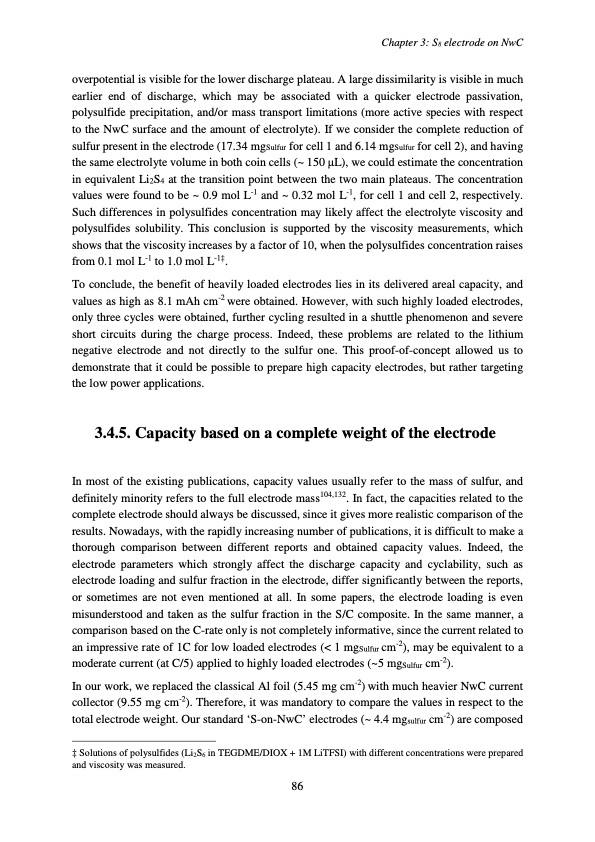
PDF Publication Title:
Text from PDF Page: 090
overpotential is visible for the lower discharge plateau. A large dissimilarity is visible in much earlier end of discharge, which may be associated with a quicker electrode passivation, polysulfide precipitation, and/or mass transport limitations (more active species with respect to the NwC surface and the amount of electrolyte). If we consider the complete reduction of sulfur present in the electrode (17.34 mgSulfur for cell 1 and 6.14 mgSulfur for cell 2), and having the same electrolyte volume in both coin cells (~ 150 μL), we could estimate the concentration in equivalent Li2S4 at the transition point between the two main plateaus. The concentration values were found to be ~ 0.9 mol L-1 and ~ 0.32 mol L-1, for cell 1 and cell 2, respectively. Such differences in polysulfides concentration may likely affect the electrolyte viscosity and polysulfides solubility. This conclusion is supported by the viscosity measurements, which shows that the viscosity increases by a factor of 10, when the polysulfides concentration raises from 0.1 mol L-1 to 1.0 mol L-1‡. To conclude, the benefit of heavily loaded electrodes lies in its delivered areal capacity, and values as high as 8.1 mAh cm-2 were obtained. However, with such highly loaded electrodes, only three cycles were obtained, further cycling resulted in a shuttle phenomenon and severe short circuits during the charge process. Indeed, these problems are related to the lithium negative electrode and not directly to the sulfur one. This proof-of-concept allowed us to demonstrate that it could be possible to prepare high capacity electrodes, but rather targeting the low power applications. 3.4.5. Capacity based on a complete weight of the electrode In most of the existing publications, capacity values usually refer to the mass of sulfur, and definitely minority refers to the full electrode mass104,132. In fact, the capacities related to the complete electrode should always be discussed, since it gives more realistic comparison of the results. Nowadays, with the rapidly increasing number of publications, it is difficult to make a thorough comparison between different reports and obtained capacity values. Indeed, the electrode parameters which strongly affect the discharge capacity and cyclability, such as electrode loading and sulfur fraction in the electrode, differ significantly between the reports, or sometimes are not even mentioned at all. In some papers, the electrode loading is even misunderstood and taken as the sulfur fraction in the S/C composite. In the same manner, a comparison based on the C-rate only is not completely informative, since the current related to an impressive rate of 1C for low loaded electrodes (< 1 mgSulfur cm-2), may be equivalent to a moderate current (at C/5) applied to highly loaded electrodes (~5 mgSulfur cm-2). In our work, we replaced the classical Al foil (5.45 mg cm-2) with much heavier NwC current collector (9.55 mg cm-2). Therefore, it was mandatory to compare the values in respect to the total electrode weight. Our standard ‘S-on-NwC’ electrodes (~ 4.4 mgsulfur cm-2) are composed ‡ Solutions of polysulfides (Li2S6 in TEGDME/DIOX + 1M LiTFSI) with different concentrations were prepared and viscosity was measured. Chapter 3: S8 electrode on NwC 86PDF Image | Accumulateur Lithium Soufre

PDF Search Title:
Accumulateur Lithium SoufreOriginal File Name Searched:
WALUS_2015_archivage.pdfDIY PDF Search: Google It | Yahoo | Bing
Sulfur Deposition on Carbon Nanofibers using Supercritical CO2 Sulfur Deposition on Carbon Nanofibers using Supercritical CO2. Gamma sulfur also known as mother of pearl sulfur and nacreous sulfur... More Info
CO2 Organic Rankine Cycle Experimenter Platform The supercritical CO2 phase change system is both a heat pump and organic rankine cycle which can be used for those purposes and as a supercritical extractor for advanced subcritical and supercritical extraction technology. Uses include producing nanoparticles, precious metal CO2 extraction, lithium battery recycling, and other applications... More Info
| CONTACT TEL: 608-238-6001 Email: greg@infinityturbine.com | RSS | AMP |